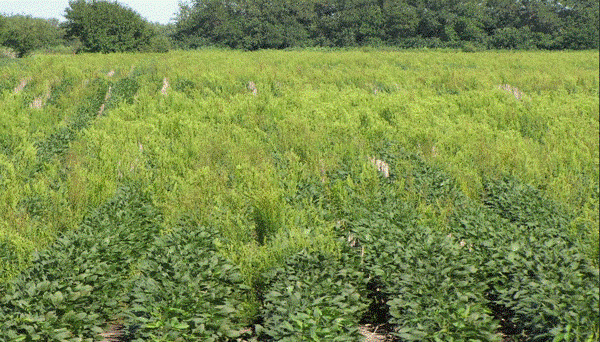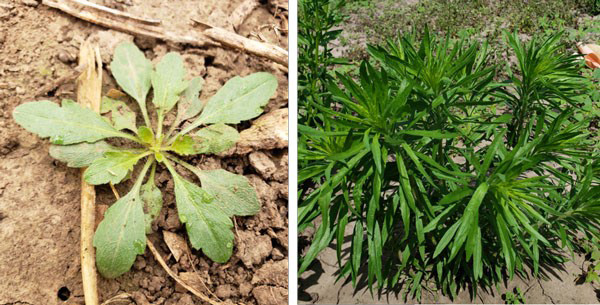Controlling marestail in soybeans can be a challenge for Kansas no-till producers. Application timing and weed size are critical factors for successfully controlling this weed germinating in the fall or early spring. Research has shown that up to 80% of marestail can die over the winter as a result of cold temperatures and/or lack of adequate moisture. In addition, a well-established cover crop in the fall can reduce marestail establishment and survival. However, marestail that does survive is often robust and can be difficult to control with herbicides, especially later in the spring. Herbicide options are also limited by widespread resistance to glyphosate and/or ALS-inhibiting (group 2) herbicides in marestail.

Figure 1. Glyphosate-resistant marestail in soybeans. Photo by Dallas Peterson, K-State Research and Extension.
Early spring options
In the early spring, using a Group 4 (growth regulator) herbicide such as 2,4-D and/or dicamba is an inexpensive and effective option to control rosette marestail (Figure 2, left). Dicamba provides better marestail control than 2,4-D and will also provide some residual control, especially at higher use rates. Haluxifen (Elevore) is a newer group 4 herbicide that can provide similar marestail control to dicamba. Making these applications in March generally allows adequate time ahead of planting soybeans to meet required pre-plant intervals, but more importantly, spraying weeds before they bolt (Figure 2, right) will result in greater control. In general, marestail in Kansas will bolt in April, so now is the time for these applications.
Using herbicides with a longer residual helps control weeds that germinate between early spring applications and soybean planting. Products that include chlorimuron (Classic, Canopy), cloransulam (FirstRate), flumioxazin (Valor, others), saflufenacil (Sharpen, Optill, Verdict), or metribuzin, can help provide residual control against several broadleaf species, including marestail. However, it is very important to consult and follow the herbicide label guidelines for the required pre-plant intervals prior to planting soybeans, as well as the proper rate for your soil. Also, keep in mind that resistance may reduce the effectiveness of ALS-inhibiting herbicides such as chlorimuron and cloransulam.

Figure 2. Marestail in the rosette growth stage (left photo) versus bolted (right photo). Photos by Sarah Lancaster, K-State Research and Extension.
Pre-plant options
As soybean planting nears, existing marestail plants can become difficult to control because plants will have bolted and be considerably larger. Herbicides to apply as a burndown prior to planting include tank mixes of glyphosate with 2,4-D and the residual products listed above.
Be very careful to follow label directions regarding plant-back restriction when applying 2,4-D ahead of soybean varieties that are not resistant to 2,4-D choline. Enlist soybean varieties have no plant-back restriction for Enlist One or Enlist Duo. However, non-resistant varieties have plant-back restrictions that range from 0 to 30 days depending on the herbicide rate and formulation, as well as soybean variety, precipitation, and geography.
One additional herbicide to consider as a rescue burndown application to control bolting marestail prior to soybean planting is glufosinate (Liberty and others). Although, it would be better to control marestail at an earlier stage of growth, glufosinate has been one of the most effective herbicides to control bolting marestail. Glufosinate is a non-selective herbicide that has activity on other broadleaf and grass species. Glufosinate is a contact herbicide, so a spray volume of 15 gallons per acre or greater generally provides the most consistent weed control. Glufosinate tends to work best under higher humidity and warm, sunny conditions at application.
Post-emergence options
Controlling marestail in the growing soybean crop can be the biggest challenge for producers, especially in soybeans that are not resistant to 2,4-D. Enlist One or Enlist Duo will be effective control options in Enlist E3 soybeans. One final post-emergence option to consider is glufosinate. Glufosinate resistance is in Liberty Link and Enlist E3varieties.
For more detailed information, see the “2025 Chemical Weed Control for Field Crops, Pastures, and Noncropland” guide available online at https://bookstore.ksre.ksu.edu/pubs/SRP1190.pdf or check with your local K-State Research and Extension office for a paper copy.
The use of trade names is for clarity to readers and does not imply endorsement of a particular product, nor does exclusion imply non-approval. Always consult the herbicide label for the most current use requirements.
Sarah Lancaster, Weed Management Specialist
slancaster@ksu.edu
Jeremie Kouame, Weed Scientist
jkouame@ksu.edu